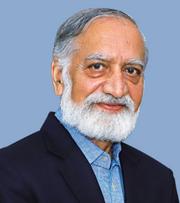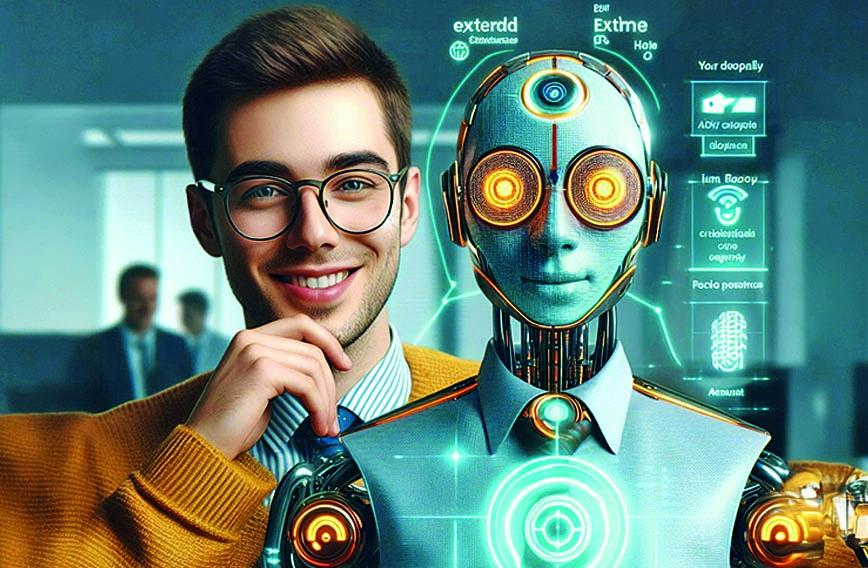
KIRAN KARNIK
I
magine suddenly having a twin: rather like the hackneyed plot of many a potboiler movie, where the hero discovers that he has a twin of whose existence he was unaware (typically separated from the family during a mela, when they were very young). Practically your clone, the twin will be you in all aspects, except the physical: s/he will exist only in digital/virtual form. This doppelganger is, therefore, not a lookalike, but will act and react just as you do, based not only on your past, but updated in real time with your ongoing experiences and life.
Far-fetched? Science fiction? No, this will be reality soon, and quicker than you might imagine. So, what exactly is a digital twin? It is a virtual replica of a system, object or process: not just a static model or 3D visualization but one which is continuously updated in real time, integrating data from sensors or other sources, analytics and AI. The mirroring of the real-world counterpart’s structure, behaviour and dynamics enables simulation, monitoring and optimization. This provides insights, prediction of outcomes, and informed decisions.
Already — for the past few years, in fact — many machines have digital twins. These are used to model factory operations, optimize production lines, predict failures, and reduce downtime. NASA used an early form of a digital twin during the Apollo 13 mission to simulate spacecraft behaviour on the ground. Many further advances have since taken place. Apart from factories, equipment and objects, large or mega-systems are beginning to use digital twins. Singapore has created a digital twin of the entire city for infrastructure planning, integrating the latest in AI, Internet of Things (IoT, which enables machine-to-machine real-time data exchange), and big data. This enables optimization of energy use, traffic flows, and urban planning. An example at product level is Tesla, which continuously updates vehicle software based on real-time data from its digital twin models.
Digital twins can be used to simulate failures and test corrective measures virtually, before any repairs or replacement of the real-world equipment or device. Predicting failures before they happen will not only save money but could prevent accidents. For example, digital twins of bridges are used to monitor stress and prevent collapse. Similar use for buildings may be invaluable in the context of frequent reports of collapses, especially amidst heavy rain. In agriculture, digital twins of farms can be used to monitor soil conditions, predict crop yields, and to simulate implications, or to optimize irrigation and pesticide usage.
An emerging use of great potential and importance is in healthcare. It is well known that the progress of any illness and the impact of medication varies from one individual to the next. Multiple factors — from genes to lifestyle — affect this; yet, given the practical constraints, treatment is, almost always, standardized and general, with fixed dosage and medicines. Where dosage or strength of the medicine requires changing, it is done on a trial-and-error basis.
With the growth in specialization and super-specialization, there is a near-extinction of the long-standing institution of the family doctor or the traditional general practitioner (GP). S/he was someone who knew your full health history, including your allergies, susceptibilities, and problems, enabling not only a holistic or systemic view of your ailment, but a degree of personalization of medication. As a result of the demise of the GP, even this degree of individual care no longer exists. Yet, latest advances point to the need for greater personalization, both for proper diagnosis and appropriate treatment.
To an extent, this is sought to be achieved by maintaining patient information in databases that can be accessed by the concerned specialist whom one consults. This requires ensuring that all data (medical history, measurements of blood pressure, sugar, weight, blood and other tests, medication taken, along with strength and dosage, etc.) is collected, collated, digitized and stored in an accessible database. This is certainly useful but is constrained by lack of current data (the last tests may be months old) and the difficulty of monitoring immediate reactions. Doing this — with immediacy, easily and quickly — requires sensors that collect and transmit the required data.
New technology is now enabling this through devices that are either implanted or, better and increasingly so, non-invasive external sensors. For example, thanks to advances in sensors, electronics and AI, there are devices that can gauge sugar levels through sweat or saliva. Others can measure blood pressure and various other blood parameters by using various parts of the electromagnetic spectrum (along the lines of an ultrasound scan for checking the kidney, liver, and various other organs).
The ability to collect such data continuously and relay it instantly makes it possible to have a digital twin that is a real-time copy of you. Data analytics and AI will help to create models, based on millions or billions of data points. The addition of individual data will help develop a personalized model for each person. This will enable simulations of reactions to medication and optimizing the dosage, a huge step forward in personalized or individual-specific medical treatment. As in machines, the twin can predict impending component/part (organ) failures, enabling repair or replacement before breakdown.
All this may be many years in the future: possibly a decade from now. However, the trend is clear, with near-certainty of outcome. Add advances in genetics and medical science, and the timeline may well be much shorter than one expects.
A digital twin will have many other uses, especially if also given a physical form as your avatar, a true doppelganger. The limiting factor may only be one’s imagination. Soon enough, one may also have a digital twin of one’s brain, vastly expanding the scope of possible uses. Quite scary, as a few moments of reflection will tell you. More on that later.
Meanwhile, prepare to discover and befriend your new twin! ν
Kiran Karnik is a public policy analyst author, and columnist. His most recent book is ‘Decisive Decade: India 2030, Gazelle or Hippo’.
Comments
Currently there are no Comments. Be first to write a comment!




